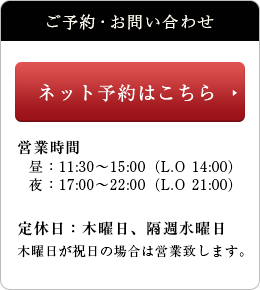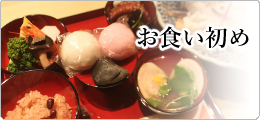Lunch Menu
11:30am to 2pm
1.Original Kaiseki( a. ¥4,000 b. ¥5,500 c. ¥7,500)
Appetizer, Tsukuri (Raw Seafood), Takiawase (Simmered Dish), Yakimono (Pan-Fried Dish), Agemono (Deep Fried Dish), Kawari bachi (Seasonal Dish), Mushimono (Steamed Dish), Su-no-mono (Vinegared Dish), Iro-Gohan (Rice), Suimono (Japanese Vegetable Soup), Dessert
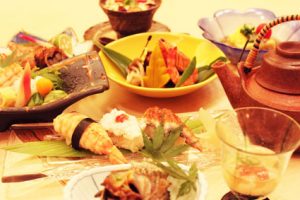
All contents are subject to change depending on the season.
2.Shokado (Kyoto Style Lunch Box) ¥3,000
Aperitif, Tsukuri (Raw Seafood), Yakimono (Pan-Fried Dish), Nimono (Simmered Dish), Agemono (Deep Fried Dish), Suimono (Japanese Vegetable Soup), Chawanmushi (Lidded Steamed Dish), Iro-Gohan (Rice), Dessert
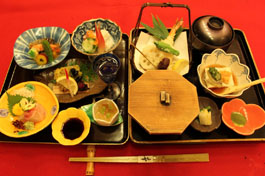
All contents are subject to change depending on the season.
3.Kou-Sushi ¥3,000
Various Sushi 8 pieces, Tsukidashi, Agemono (Deep-Fried Dish), Nimono (Simmered Dish), Chawanmushi (Lidded Steamed Dish), Suimono (Japanese Style Soup), Dessert
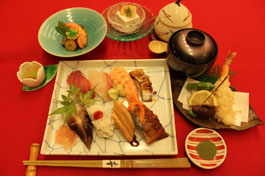
All contents are subject to change depending on the season.
4.Seasonal Dishes, please refer the menu of the seasonal food.
Dinner Menu
1.Original Kaiseki( a. ¥4,000 b. ¥5,500 c. ¥7,500)
Appetizer, Tsukuri (Raw Seafood), Takiawase (Simmered Dish), Yakimono (Pan-Fried Dish), Agemono (Deep Fried Dish), Kawari bachi (Seasonal Dish), Mushimono (Steamed Dish), Su-no-mono (Vinegared Dish), Iro-Gohan (Rice), Suimono (Japanese Vegetable Soup), Dessert
Original Kaiseki All contents are subject to change depending on the season.
2.Seasonal Dishes, please refer the menu of the seasonal food.
Sashimi (Raw Seafood), Nimono (Simmered Dishes), (Various Kinds of Tofu), Tempura, Aemono (Dishes dressed with various kinds of sauce), Meat Cuisine, Grilled Fish, Su-no-mono (Vinegared Dishes), Shirumono (Soup), Chinmi (Delicacies), etc…
3.Hot-Pot (Cooked at the table) (Reservation Only)
Tecchiri (Globefish Hot-Pot) ¥5,000〜/Kanisuki (Crab Hot-Pot) ¥5,000〜(Soft Shelled Turtle, Conger Pike (Summer Only) etc…)
4.Various Sushi
Tuna, Shiromi (fish with white flesh), Thin Roll, Pressed Sushi, etc…
Special Terms Used in Japanese Cuisines
Rough Translation is “Appetizer”
Meaning: Your orders have been told to the kitchen. They will be served soon, please have something little for a while.
Rough Translation is “Sliced Raw Fish”
It is said “Japanese Cuisines are Based on Seafood”.
What represents Japanese Cuisine is Having Raw Seafood.
Rough Translation is “Simmered/Stewed/Boiled Dishes
Decollate more than 3 kinds of boiled food in one dish.
Each food is cooked separately to keep the natural taste of each food. This cooking style of Nimono is often seen especially in Kansai (west) area of Japan.
Rough Translation is “Grilled and Pan fried dishes”
In Japanese Cuisine, it is mainly Fish. The amount of heat applied, the usage of skewers, the order of cooking differ depending on each food and it is very important fact to maximize the joy of tastes.
Rough Translation is “Deep Fried Dishes”
In Kaiseki (see the reference below), Agemoto is usually a combination of a sea bream, a sillaginoid, a scorpion fish, a prawn, and, or, a conger pike, and some seasonal vegetables.
Rough Translation is “Substitute Dishes”
The dish served as a substitute of one dish from the main structural elements of Japanese Cuisine, which is called “Ichijiru-Sansai (see the reference below)”.
Rough Translation is “Steamed Dishes”
Mushimono is heated by steam. The best thing is steam never let the good things flow out from the food during the cooking process.
Rough Translation is “Vinegared Dishes”
Su-no-mono not only improves your appetite but also washes your mouth and recovers your fatigue. It is served to refresh your mouth before eating rice.
Rough Translation is “Rice, Pure soup (Last Dish), Pickles”
In Kaiseki, Gohan, Suimono, and Kounomono are served after guests enjoyed various dishes with alcoholic drinks. Last dish literally means that this is the end of the course.
Generally, seasonal fruits are served for dessert. Sometimes, not only fruits but also Japanese snacks are served to refresh your mouth. The start of serving fruits is not so long time ago, and it is an extra cuisine.
What is Kaiseki?
There are two kinds of Kaiseki, both of which are from the same root. One is served at parties and alcohol drinking places, the other one is served at tea ceremonies.
General Flow of Kaiseki Course
Sakizuke (Appetizer), Wanmono (Soup), Mukozuke (Raw Seafood), Yakimono, Nimono, Last Dishes (based on Su-no-mono (or Aemono), Meal (Gohan, Last dish, Kounomono), Dessert (Fruits).
Generally, Kaiseki Course are served in order according to the list above with alcoholic drinks. Sometimes, Agemono, Mushimono, and Nabemono are served depending on the place and the season.
(At KOU, we have made a slight change on this flow.)
Here are Quick Reference to understand Japanese Cuisine
- Grilled and pan-fried dishes (yakimono ),
- Stewed/simmered/cooked/boiled dishes (nimono ),
- Stir-fried dishes (itamemono ),
- Steamed dishes (mushimono ),
- Deep-fried dishes (agemono ),
- Sliced raw fish (sashimi),
- Soups (suimono and shirumono ),
- Pickled/salted vegetables (tsukemono),
- Dishes dressed with various kinds of sauce (aemono ),
- Vinegared dishes (su-no-mono ),
- Delicacies, food of delicate flavor (chinmi).[23]
- One soup, three dises (ichijiru sansei)
- Tea ceremony (chaseki)
Kaiseki
- Sakizuke : an appetizer.
- Hassun : the second course, which sets the seasonal theme. Typically one kind of sushi and several smaller side dishes.
- Mukōzuke : a sliced dish of seasonal sashimi.
- Takiawase : vegetables served with meat, fish or tofu; the ingredients are simmered separately.
- Futamono : a “lidded dish”; typically a soup.
- Yakimono : (1) flame-grilled food (esp. fish); (2) earthenware, pottery, china.
- Su-zakana : a small dish used to clean the palate, such as vegetables in vinegar; vinegared appetizer.
- Hiyashi-bachi : served only in summer; chilled, lightly cooked vegetables.
- Naka-choko : another palate-cleanser; may be a light, acidic soup.
- Shiizakana : a substantial dish, such as a hot pot.
- Gohan : a rice dish made with seasonal ingredients.
- Kō no mono : seasonal pickled vegetables.
- Tome-wan : a miso-based or vegetable soup served with rice.
- Mizumono : a seasonal dessert; may be fruit, or cake.
10% of gratuity will be added to the price shown above.














